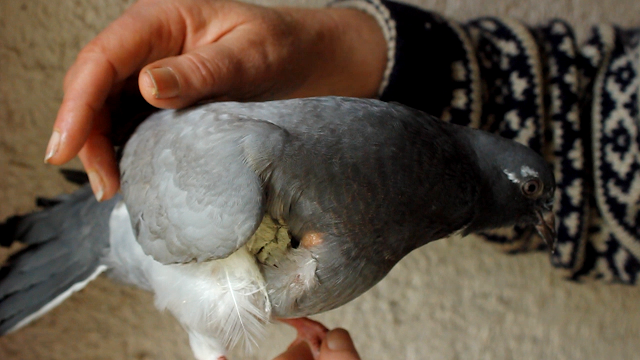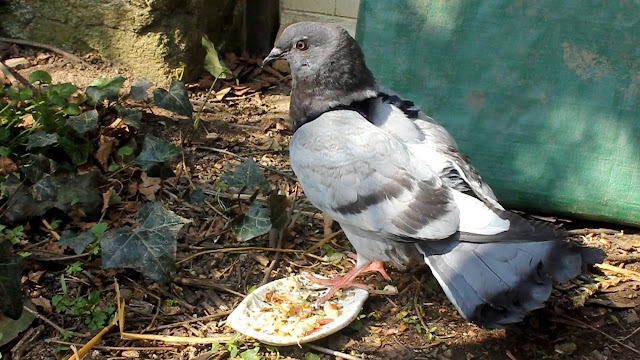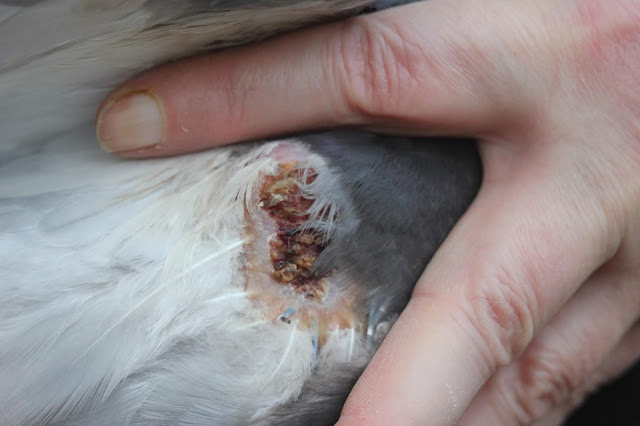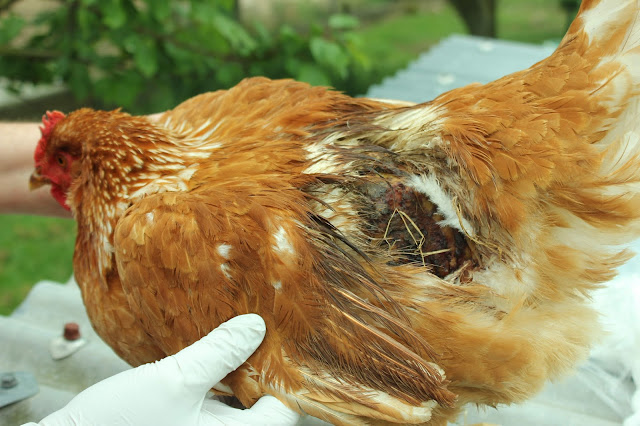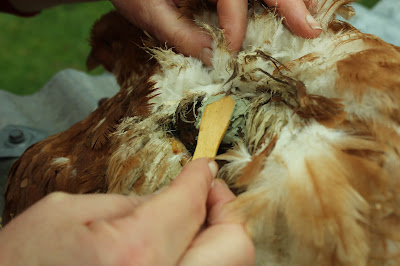In Part One and Part Two of these articles respectively we looked at dealing with the emotional stress aspect of the injury and then moved on to coping with the pain, potential bacterial infection and immune system response element. Now I'm going to share how I sealed and healed the wound with therapeutic clay.
 Always choose a good quality, sun-dried, powdered clay from a reputable
source, it is not expensive and if stored correctly will keep well.
Normally a clay compress is only left on until dry. However, with my pigeon, I was going to keep the clay on for as long as possible to cover the wound, seal the hole in the crop and to avoid infection.
Always choose a good quality, sun-dried, powdered clay from a reputable
source, it is not expensive and if stored correctly will keep well.
Normally a clay compress is only left on until dry. However, with my pigeon, I was going to keep the clay on for as long as possible to cover the wound, seal the hole in the crop and to avoid infection.
Mixing Bowls: due to the clays ability to remove toxins, only stable substances such as glass or porcelain should be used to mix the clay. So do not use metal (see following paragraph). Above all do not use plastic the clay will withdraw toxins from it.
Spoons: do not use silverware i.e. metal spoons, as this will have an ionic reaction on the clay that is in direct contact with it. Certainly this is a tiny amount but even so it is better to use a wooden, glass or ceramic spoon. I save lolly sticks for the very purpose of using them with clay. We were very lucky the other day to be at a friend's house, when we were all offered organic ices, I went around collecting up the sticks!
Water: you should also use good quality water too, in our case this means mineral water as our tap water is loaded with nitrates!
Keep the body hydrated: by the very action of the clay it will draw water from the body.
Covering: the clay will react with the air around it and obviously dry accordingly, in order to concentrate the clay onto the wound and to allow it to dry more slowly and thus be active longer, the former can be covered with an organic fabric such as a pad or in my case piece of old Tee-shirt.
Furthermore, he now can bend without any problem and in fact began to eat food at floor level.
Here by comparing the above with the picture at the top of this article you can see exactly the amazing healing power of clay in just over a fortnight!
Here are the two films:
Thanks for dropping by and do feel free to share experiences or ask for further information in the comment section. If you have enjoyed this piece and found it
useful think about sharing it with your family and friends, on social media and also maybe about joining this blog
and/or subscribing to my Youtube channel or even supporting us on
Patreon or
It all helps to keep me going!
Until next time, all the very best from Normandie! Sues

The first thing to understand if you haven't used it before is, that because of the way it reacts with other substances, clay has a protocol that must be followed.
Therapeutic Clay - Its properties and how to use it on wounds
Therapeutic
clay is one of the most amazing, natural minerals, its primary use being as a detox for the body. It can remove bacteria from wounds and heavy metals and even radiation from the body, with both internal and external application. I have also used it to great effect on sprains and sciatica and a friend has used it to successfully set her dog's broken leg! Here I'm using Montmorillonite aka French Green Clay but you should check out the clays in your local area, as there are a whole raft of therapeutic ones if you are in the UK, where I was when I first started using clay then you can buy the Cattier Clay I use here on-line:
 Always choose a good quality, sun-dried, powdered clay from a reputable
source, it is not expensive and if stored correctly will keep well.
Normally a clay compress is only left on until dry. However, with my pigeon, I was going to keep the clay on for as long as possible to cover the wound, seal the hole in the crop and to avoid infection.
Always choose a good quality, sun-dried, powdered clay from a reputable
source, it is not expensive and if stored correctly will keep well.
Normally a clay compress is only left on until dry. However, with my pigeon, I was going to keep the clay on for as long as possible to cover the wound, seal the hole in the crop and to avoid infection.
On
the left is an amazing photo of Macaws, showing how they have learned
to use the properties of clay, as a way of getting nutrition from
potentially toxic foods. The clay envelopes the alkaloids present in the
seeds of many of the fruits they consume, toxins which are particularly
concentrated in the dry season and passes them out of the body in the
parrots' droppings!
Clay Protocol
Mixing: always mix by putting the powder into the recipient first and then adding water, this is the easiest way to gauge exactly how much water to use.Mixing Bowls: due to the clays ability to remove toxins, only stable substances such as glass or porcelain should be used to mix the clay. So do not use metal (see following paragraph). Above all do not use plastic the clay will withdraw toxins from it.
Spoons: do not use silverware i.e. metal spoons, as this will have an ionic reaction on the clay that is in direct contact with it. Certainly this is a tiny amount but even so it is better to use a wooden, glass or ceramic spoon. I save lolly sticks for the very purpose of using them with clay. We were very lucky the other day to be at a friend's house, when we were all offered organic ices, I went around collecting up the sticks!
Water: you should also use good quality water too, in our case this means mineral water as our tap water is loaded with nitrates!
Keep the body hydrated: by the very action of the clay it will draw water from the body.
Covering: the clay will react with the air around it and obviously dry accordingly, in order to concentrate the clay onto the wound and to allow it to dry more slowly and thus be active longer, the former can be covered with an organic fabric such as a pad or in my case piece of old Tee-shirt.
Clay Treatment
Day 1
Here I'm using my lolly stick to add on the clay. It was important that I had already given the pigeon his drink of electrolyte and he had drunk well, thus was hydrated. I didn't want to give him any more significant quantities of liquid, which might leak out through the clay until it had begun to set.Day 2
Below, showing the state of the clay on the following day after the injury and now with the clay dried and thus I could risk giving a longer drink.
At this point I was hand-feeding my pigeon as he was still disinclined to eat. Whether it was hurting him to bend or that the descent of the food going into his crop was causing him a problem. However, when I hand-fed him he swallowed, so I took that as a sign of acceptance! I also believe that it is not too fanciful a hypothesis that in times of emotional upheaval a bird will naturally 'go back to Mama', thus my hand feeding him gave him that contact he would have had as a baby.
Day 4
The wound looks ever better and is healing well. The skin around the edges of the clay looks clean and a healthy pink. The pigeon seems at ease and was eating on his own but just in case this was still an issue I held the food up at a convenient level. N.B. because I thought this might be painful and/or stressful I am feeding him in low lighting and in the kitchen near the warmth of the wood cooker.
Day 5
The wound is obviously continuing to seal and heal. I can neither see nor more importantly, smell, any sign of infection.Furthermore, he now can bend without any problem and in fact began to eat food at floor level.
Day 6
With the pigeon's continued improvement he began to get more 'uppity' and to start pulling at the clay. So I'd had to add another thin clay layer which kept everything sealed around the edges of the wound. It is also quite natural as the pigeon improves that he will want to preen his feathers and this could be part of the problem and why he has 'accidentally' removed small amounts of clay. I gave him the benefit of the doubt!
Day 9
With the drying out of the clay which was probably slightly itchy, my pigeon which was a lot younger, more skittish and inquisitive than the other pigeon I had treated, had begun to remove the clay again. To try and stop this I made him a 'Tee-shirt' out of an old organic one of mine. On this day he also feels confident enough to face the World once more but I place him in an arbor to give him an additional feeling of safety.
Day 13
The Tee-shirt being rather an unwieldy garment, I took it off with the result that the pigeon manages to remove all the clay. Happily the wound looks fine. N.B. I have never removed dried clay from any bird I have treated as I would be totally afraid of harming it. Done at its own pace, if and when it wants to remove it, is OK by me!
Day 15
Here by comparing the above with the picture at the top of this article you can see exactly the amazing healing power of clay in just over a fortnight!
Day 27
In just under four weeks from the day of the attack the pigeon's new feathers have grown and the wound has all but disappeared.Here are the two films:
Until next time, all the very best from Normandie! Sues
RELATED ARTICLES

Initial Treatment Badly Injured Pigeon with pierced crop
I've got to be one of the World's worse nurses. However, I needed to assess the situation and
merit my pigeon's obvious confidence..read more
Badly Injured Pigeon with pierced crop 2 - Essential Oils
How
to use EOs as an antimicrobial, pain-killer and immune system support
on a nasty wound and why I use organic cotton products..read more
 Using therapeutic clay on a deep infected pigeon wound
Using therapeutic clay on a deep infected pigeon wound
Montmorillonite or (French Green) clay is one of the most amazing
natural minerals and around the World there are similar
therapeutic-grade clays for you to use, wherever you may live...read more











